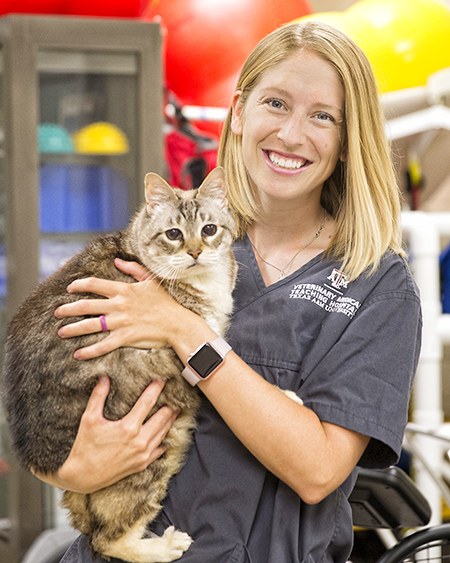Stronger Together–Pets find comfort and care in the hands of veterinary technicians

Veterinary technician Abby Rafferty and Carl
Though veterinarians play an important role in treating and caring for pets, they are not the only people involved in pet care. Veterinary technicians provide innovative technical support in patient health and recovery at the Texas A&M College of Veterinary Medicine & Biomedical Sciences (CVM).
Some responsibilities of veterinary technicians include restraining a patient for a physical exam, checking vital signs, administering medications, obtaining diagnostic samples, monitoring a patient under anesthesia, and assisting a veterinarian during a surgical procedure.
However, some veterinary technicians are certified in special areas, such as Abby Rafferty, a certified canine rehabilitation practitioner in the CVM’s Veterinary Sports Medicine and Rehabilitation (VSMR) Service. Earning a certification allowed Rafferty to learn how to help pets recover from surgery, illness, or injuries through assisted therapy.
“As a canine rehabilitation practitioner, I help animals get back up on their feet,” Rafferty explained. “Dogs that can’t walk after surgery or an injury need special exercises to recover, such as assisted standing, weight shifting, or walking on a water treadmill. That’s where I come in to help.”
The water treadmill, one of the VSMR’s most effective therapy machines, is described by Rafferty as “a valuable tool that is really neat to see.” Patients that need this kind of assisted therapy are placed in warm water on a treadmill and walk to regain their strength; the treadmill eases pressure on their joints.
“The water supports the animal’s weight and makes them buoyant so they don’t have to worry about dragging on the ground or hurting themselves,” Rafferty said. “But at the same time, the treadmill provides a little bit of resistance that the animals have to walk through.”
In addition to the water treadmill, Rafferty is trained to help patients heal through other therapeutic techniques, such as massaging, stretching to increase the range of motion, and even balancing exercises. If the patient requires intense physical therapy, special equipment may be needed to help the patient heal.
“Some cases require electrical stimulation,” Rafferty said. “We can use neuromuscular electrical stimulation, which allows the muscles to contract to help maintain muscle mass in patients that are immobile, or we can use transcutaneous electrical stimulation for pain relief.”
Though people are often expected to follow up surgery or an injury with physical therapy, it is less common that pets receive the same treatment. However, Rafferty explained that it is just as important for pets to participate in therapy as it is for humans.
“Therapy can help speed recovery and get pets back on their feet faster,” Rafferty said. “It doesn’t mean that an animal won’t ever return to normal function if they don’t have therapy, but it has the ability to help them recover quicker.”
Rafferty described one case of a hunting dog that had fractured its ankle. By participating in therapy, the dog managed to stay in shape through recovery and healed fast enough to save its career. As one of the main veterinary technicians who helped the patient recover, Rafferty said it was a case she will never forget.
“This dog needed to get better so he could return to his job,” Rafferty explained. “Otherwise, he would have to retire at such a young age. Naturally, I felt the pressure.”
Because the dog lived an active lifestyle, Rafferty helped create a specialized treatment plan that allowed the dog to exercise outside. Though she could have exercised the dog on a treadmill indoors, Rafferty knew exercising outside was the best way to keep the dog in shape for his hunting career.
“The dog and I would jog from the hospital to across the parking lot and even up and down stairs,” Rafferty said. “I knew he was a fit hunting dog, so jogging outside was necessary to keep him in shape and conditioned to warmer temperatures.”
Although veterinary technicians such as Rafferty help many furry patients recover and return to their normal lives, sometimes veterinary technicians face being unable to restore a patient’s quality of life.
“There are certainly challenges,” Rafferty said. “As a more specialized technician, I don’t deal with euthanasia as often, but when I do, it’s harder for me because it’s typically a patient that I’ve been working really hard with or one that I’ve become attached to.”
Despite these challenges, Rafferty said being a veterinary technician is ultimately rewarding and that happy times outweigh the bad.
“You can’t let sad moments drag you down,” Rafferty said. “You have to think of all of the happy and rewarding moments because that’s what makes the job worth it.”
Owners of pets and other animals expect state-of-the-art veterinary health for their animals, just as they would expect quality care for themselves and family members. At the CVM, veterinary technicians provide such care, as well as a comforting hand for those pets.


